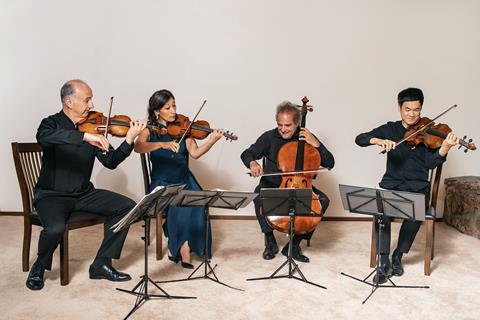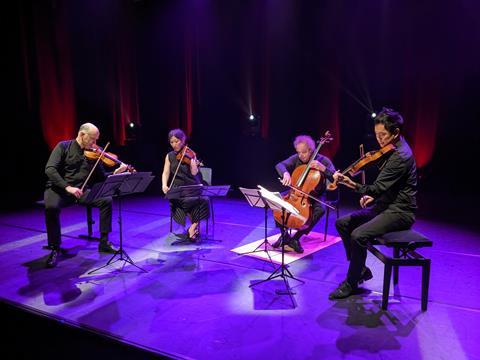Beethoven’s String Quartet no.8 has been a life companion for the British musician, over more than three decades as the Takács Quartet’s first violinist

Discover more Featured Stories like this in The Strad Playing Hub.
Read more premium content for subscribers here
There are some pieces of music that accompany you throughout your musical life: they rearrange themselves in your head and you find new facets within them as you evolve as a musician. Beethoven’s String Quartet no.8 in E minor is a piece that never grows old for me, and I feel there’s always something more to be discovered in it. And in my 31 years as first violinist of the Takács Quartet it’s reflected so many of the changes we’ve gone through as an ensemble.
The first time I remember it making an impact on me was when my parents took me to hear a performance by the Allegri Quartet in Cambridge. I was around 13 and I can still remember the slow movement, when first violinist Peter Carter climbed up and up the scale, crested twice and came down to an underlying chord. Until then I hadn’t realised the ethereal potential of the instrument, as he played it with such serenity and wonder. I also remember talking about the piece with my mother, a keen amateur violinist who played it with her friends, and how she highlighted the descant passage of the second movement as one of her favourites.
Later on, I heard the Alberni Quartet perform it, while I was studying with its first violinist Howard Davis. The players’ agility amazed me, especially the skill with which they passed the lines between them, and the scurrying, breathless quality of that first movement. Howard always had a huge amount of positive energy and when I said how hard the piece sounded, he laughed and said how lucky we were that we had such great music to perform! To be honest, I felt daunted by the piece, and didn’t seriously try playing it until I’d joined the Takács, while in my last year at Juilliard.

At that time, I read as much as I could about the piece and how it was written. I learnt how Count Rasumovsky – like my mother, an amateur player – had commissioned it from Beethoven, and not long after trying to play it (and the other two ‘Rasumovsky’ quartets) decided just to be a listener instead! And when one violinist declared that the quartets were ‘not music’, Beethoven replied, ‘They are not for you, but for a later age.’ So here I was, in that ‘later age’ and I had to play them!
This was the last piece I played with the Takács founder violist Gábor Ormai, who left just a year after I’d joined; he died of cancer six months afterwards, and I still associate the piece with that sad, difficult time for us all. Then we were joined by violist Roger Tapping, formerly of the Allegri, though not at the time I’d heard them in Cambridge. He brought a real sense of the quartet’s harmonic underpinnings and brought a tremendous sense of exploration to our rehearsals. When he retired in 2005 he was followed by Geraldine Walther, who came from an orchestral background and brought a real sense of fun to playing quartets. Finally, Richard O’Neill joined in 2020 and the piece evolved again: when my mother heard it up in Cambridge, she remarked on how dramatic it sounded, particularly the startling chords and intimate silences of the first movement. Looking back to those first audiences who didn’t like the piece, I think there’s still something so disruptive and radical about this music that retains the ability to shock.
We’re now performing the quartet with a new commission by Nokuthula Ngwenyama called Flow, in a programme based around the natural world. We open with Haydn’s ‘Sunrise’ quartet, which contrasts with the second movement of the Beethoven, and which was apparently inspired by the night-time stars and the ‘music of the spheres’. It’s a gorgeous piece, quite difficult to pace, and the best way to find your way into it is to hold on to that unique sense of wonder and sweetness embodied within it.
INTERVIEW BY CHRISTIAN LLOYD
Watch: Masterclass: The Takács Quartet performs Brahms’s String Quartet no.3
Read: Takács Quartet to welcome new violist in 2020
Discover more Featured Stories like this in The Strad Playing Hub.
Read more premium content for subscribers here
The number one source for playing and teaching books, guides, CDs, calendars and back issues of the magazine.
In The Best of Technique you’ll discover the top playing tips of the world’s leading string players and teachers. It’s packed full of exercises for students, plus examples from the standard repertoire to show you how to integrate the technique into your playing.
The Strad’s Masterclass series brings together the finest string players with some of the greatest string works ever written. Always one of our most popular sections, Masterclass has been an invaluable aid to aspiring soloists, chamber musicians and string teachers since the 1990s.
American collector David L. Fulton amassed one of the 20th century’s finest collections of stringed instruments. This year’s calendar pays tribute to some of these priceless treasures, including Yehudi Menuhin’s celebrated ‘Lord Wilton’ Guarneri, the Carlo Bergonzi once played by Fritz Kreisler, and four instruments by Antonio Stradivari.













































No comments yet